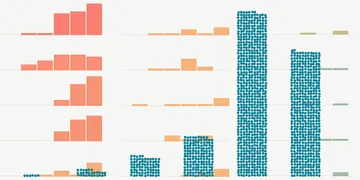In 2022, The Marshall Project looked at trends in mass shootings in the U.S. Here is an update of that piece.
Last week, a gunman opened fire in Lewiston, Maine, ultimately killing at least 18 people at a bowling alley and a nearby bar. He was found dead after a two-day manhunt. Maine, which has one of the lowest homicides rates in the nation, remains in shock.
If it feels like U.S. mass shootings have become more frequent, that intuition remains correct, according to data analysis by The Marshall Project.
Under even one of the most conservative definitions of “mass shootings,” in which a gunman slaughters four or more strangers in a public place, the number of these crimes has indeed been climbing in the last few years — and they have higher death tolls, as well.
Mass shootings account for just a fraction of the daily toll of firearm deaths in the U.S., where about 132 people died every day in acts of gun violence in 2022.
Our analysis is based on data through 2022 from The Violence Project, a nonprofit research group that uses a narrow definition of mass shootings adopted from the Congressional Research Service, which advises federal lawmakers.
Thirty-three of these massacres occurred from 2018 through 2022, compared with 25 from 2013 through 2017, according to The Violence Project data. We compared five-year periods, rather than annual data, so we could more clearly see trends over time. A focus on yearly data would be skewed by 2020, when there were two mass shooting incidents, which researchers attribute to the COVID-19 lockdown.
Still, the latest five-year period saw more attacks than any other comparable timespan dating back to 1966 — an average of about 6.6 mass shootings per year since 2018.
The Violence Project defines mass shootings as single incidents in which four or more people are killed (not including the shooter), in public locations, such as schools, stores, or workplaces. It excludes murders that occur as a result of other crimes, such as domestic violence, robbery and gang violence.
At least seven mass shootings so far in 2023 fit this definition:
- Monterey Park, California: 11 dead, 9 injured.
- Half Moon Bay, California: 7 dead, 1 injured.
- Nashville, Tennessee: 6 dead.
- Louisville, Kentucky: 5 dead, 8 injured.
- Allen, Texas: 8 dead, 7 injured.
- Philadelphia, Pennsylvania: 5 dead, 2 injured.
- Lewiston, Maine: 18 dead, 13 injured.
This means 2023 is on par with the number of mass shootings in recent years. The Violence Project counted eight mass shootings in 2021, and seven in 2022.
As mass shootings in the U.S. reached a record high, so did the number of deaths and injuries. From 2018 to 2022, perpetrators killed 257 people — close to the 266 fatalities in the five-year period that ended in 2017, and significantly more than any previous period.
The rise in deaths and injuries from 2013 through 2017 was mostly due to the deadliest mass shooting in modern U.S. history. At a Las Vegas music festival in 2017, a gunman with multiple assault weapons killed at least 60 people. Over 850 people were injured, including scores hurt in a stampede, according to The Violence Project.
Our analysis shows that in the past five years, assault-style weapons have been used in half of mass shootings. Prior to 2013, they were used in one-third or fewer of all mass shootings.
There is no national, legal definition of a “mass shooting.” Several organizations track this form of gun violence, but use different yardsticks.
In 2024, we will update these charts with full data from 2023. For more on mass shootings and how they are defined, see our full analysis from 2022.
